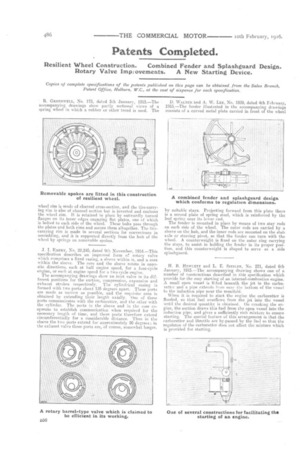Patents Completed.
Page 20

If you've noticed an error in this article please click here to report it so we can fix it.
Resilient Wheel Construction. Combined Fender and Splashguard Rotary Valve Improvements. A New Starting Device.
Design.
Copies of complete specifications of the patents published on this page can be obtained, from the Sales Branch, Patent Office, Holborn, WC., at the cost of sixpence for each specification.
R. GREENWELL, No. 173, dated 5th "January, 1915.—The D. WairEn.and A. W. LEE, No. 1828, dated 4th February,
accompanying drawings show partly sectional views of a 1915.—The fender illustrated in the accompanying drawings spring wheel in whiclia rubber or other tread is used. The consists of a curved metal plate carried in front of the wheel wheel rim is made of channel cross-section, and the tire-carrying rim is also of channel section but is inverted and encloses the wheel rim. It is retained in place by outwardly turned flanges on its inner edges engaging flat. plates, one of which is bolted to each side of the wheel. These bolts pass through the plates and both rims and secure them altogether. The tirecarrying rim is made in several sections for convenience in . assembling, and it is supported directly from the hub of the wheel by springs on removable spokes.
J. I. EMERY, No. 22,245, dated 9th November, 1914.—This specification describes an improved ferm fit' rotary valve which comprises a fixed casing, a sleeve -within it, and a core within the sleeve. The core and the sleeve rotate in opposite. directions, each at half engine speed, for a four-cycle. engine, or each at engine speed for a two-cycle engine.
The accompanying drawings show an inlet valve in its different positions for the suction, compression, expansion and exhaust strokes respectively. Time cylindrical casing is formed with two ports about 135 degrees apart. These ports are made as narrow as 'possible, and the reqnisite area is obtained by extending their length axially. One of these ports communicates with the carburetter, and the other with the cylinder. The ports in the sleeve and in the core cooperate to to establish communication when required for the necessary length of time, and these ports therefore extend circumferentially for a considerable distance. Thus in the sleeve the two ports extend for approximately 90 degrees; in the exhaust valve these ports are, of course, somewhat longer. by suitable stays. Projecting forward from this plate there is a second plate of spring steel, which is reinforced by the leaf spring near its lower end.
The fender is mounted in place by means of two stay rods on each side of the wheel. The outer rods are carried by a sleeve on the hub, and the inner rods are mounted on the stub axle or steering pivot, so that the fender can turn with the wheel. A counterweight is fixed on the outer ring carrying the stays, to assist in holding the fender in its proper position, and this counterweight is shaped to servo as a side splashguard.
R. B. HEWLETT and L. E. SITZLER, No. 221, dated 6th January, 1915.—The accompanying drawing shows one of a number of constructions described in this specification which provide for the easy starting of an internal-combustion engine. A small open vessel is fitted beneath the jet in the carburetter and a pipe extends from near the bottom of the vessel to the induction pipe near the manifold.
When it is required to start the engine the carburetter is flooded, so that fuel overflows from the jet into the vessel until the desired quantity is obtained. On cranking the engine, the suction draws this fuel from the open vessel into the induction pipe, and gives a sufficiently rich mixture to ensure starting. The special feature of this arrangement is that the carburetter and throttle are by-passed by the fuel so that the regulaton of the carburetter does not affect the mixture which is provided for starting.




















